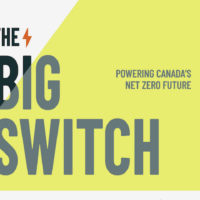This opinion piece originally ran in the Edmonton Journal.
October is here, and with it comes “spooky season”—shorter days, colder nights and a scary new marketing campaign. Alberta’s “Tell the Feds” ads paint a ghostly picture of rolling blackouts and surging power prices, all supposedly driven by Ottawa’s proposed clean electricity regulations.
But Albertans need not fear this doom-and-gloom future. Three of the campaign’s central claims don’t stand up to scrutiny.
Keeping Alberta’s grid reliable
Alberta’s campaign claims that forcing the province’s power grid to run on wind and solar “alone” would leave Albertans without electricity when they need it most.
A chilling prospect, to be sure—except that’s not what’s being proposed.
The regulations would allow newer gas plants to continue serving the grid for a period well beyond 2035 without constraint, and for all gas plants to provide power within certain limits when demand peaks or renewables aren’t producing. And in case of emergency, natural gas generation could operate as needed to ensure electricity remains reliable.
As others have proposed, tweaks to the rules could provide additional flexibility and security. The federal government has not yet finalized the draft regulations – consultations are ongoing, and changes to the final draft are to be expected.
Keeping electricity reliable throughout the transition to less-polluting sources is essential. That’s why the regulations allow for a wide variety of other power options to come into the mix, like natural gas power with carbon capture, energy storage, nuclear, and greater interconnection with neighbouring grids.
Keeping electricity rates down
The Tell the Feds Campaign claims that the proposed federal regulations will double, triple or even quadruple power rates. But there is no credible analysis showing this outcome.
The cheapest electricity supply option is now a mix of wind and solar balanced with other power sources, like natural gas or hydro. With electricity generation from Alberta’s nation-leading wind and solar resources more than doubling over the last five years, Alberta is in a strong position to build the diverse and reliable grid that its 21st century prosperity will depend on.
While meeting growing demand for electricity will require new investment up front, that’s true regardless of whether that power comes from cleaner sources or not. And if the province commits to a clean power future, it will have help with the investment costs – the federal government has put more than $40 billion on the table to help provinces build bigger, cleaner, smarter grids.
Keeping momentum going
The Tell the Feds campaign says Ottawa’s electricity goals can be achieved by 2050, but that anything sooner is unrealistic. In reality Alberta has good options to build a reliable, affordable, low carbon grid. The main danger is Alberta’s push to delay.
Until the recent moratorium, renewables like wind and solar were booming in Alberta, due to their low costs and Alberta’s market-led approach to generation investment. While it’s true that as renewables continued to grow, the grid would have eventually struggled to accommodate them, hitting the brakes doesn’t solve anything. The real problem is that Alberta’s current market rules don’t sufficiently reward sources of grid flexibility that can balance renewables, while transmission planning is reactive rather than proactive.
By laying out clear, technology-neutral requirements, the regulation will drive proactive infrastructure development in the regulated parts of the sector (transmission and distribution) and motivate overdue market rule changes in the deregulated part (generation).
This is the work Alberta needs to get on with – instead of banning renewables with little justification and scaring away prospective investors by saying blackouts are inevitable. And while the build-out of the province’s electricity system will require up-front investment, Alberta has a willing federal partner with deep pockets that’s ready to help fund the transition – as it is now doing in Nova Scotia and New Brunswick.
Albertans deserve more facts and less fear mongering about the province’s electricity future. The government of Alberta and its electricity system operator should get to work leveraging the province’s natural strengths and use existing policy tools to do what experts agree is already possible: building a cleaner electricity grid that provides affordable, reliable power to Albertans.
Sara Hastings-Simon is an associate professor in the Department of Earth, Energy, and Environment and School of Public Policy at the University of Calgary, and co-host of the Energy vs Climate podcast. Jason Dion is the Senior Research Director at the Canadian Climate Institute, a national non-partisan climate policy research organization.








